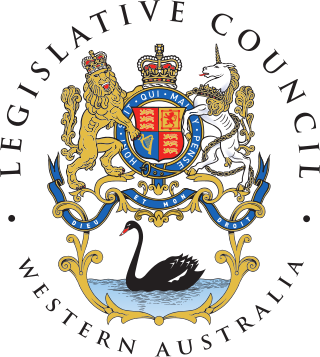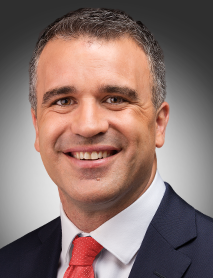Related Research Articles

The Legislative Council, or upper house, is one of the two chambers of the Parliament of South Australia. Its central purpose is to act as a house of review for legislation passed through the lower house, the House of Assembly. It sits in Parliament House in the state capital, Adelaide.

The House of Assembly, or lower house; Is one of the two chambers of the Parliament of South Australia. The other is the Legislative Council. It sits in Parliament House in the state capital, Adelaide.
In Australia, one vote, one value is a democratic principle, applied in electoral laws governing redistributions of electoral divisions of the House of Representatives. The principle calls for all electoral divisions to have the same number of enrolled voters, within a specified percentage of variance. The electoral laws of the federal House of Representatives, and of the state and territory parliaments, follow the principle, with a few exceptions. The principle does not apply to the Senate because, under the Australian constitution, each state is entitled to the same number of senators, irrespective of the population of the state.

The Parliament of South Australia is the bicameral legislature of the Australian state of South Australia. It consists of the 47-seat House of Assembly and the 22-seat Legislative Council. General elections are held every 4 years, with all of the lower house and half of the upper house filled at each election. It follows a Westminster system of parliamentary government with the executive branch required to both sit in parliament and hold the confidence of the House of Assembly. The parliament is based at Parliament House on North Terrace in the state capital of Adelaide.

The Western Australian Legislative Council is the upper house of the Parliament of Western Australia, a state of Australia. It is regarded as a house of review for legislation passed by the Legislative Assembly, the lower house. The two Houses of Parliament sit in Parliament House in the state capital, Perth.

The principles of the current Constitution of South Australia, also known as the South Australian Constitution, which includes the rules and procedures for the government of the State of South Australia, are set out in the Constitution Act 1934. Its long title is "An Act to provide for the Constitution of the State; and for other purposes".

The Western Australian Legislative Council was elected from six multi-member electoral regions, which are in turn composed of electoral districts which are used to elect the Legislative Assembly. The current number of electoral regions was established on 22 May 1989. Initially, the South West and Northern Metropolitan regions returned seven members to the Legislative Council, while the other regions each returned five members. This arrangement was changed to have each region return six members for the 2008 Western Australian election, increasing the total number of members from 34 to 36. Before 1989 electoral divisions for the Legislative Council were known as electoral provinces.
Stanley was an electoral district of the House of Assembly in the Australian state of South Australia.
East Adelaide was an electoral district of the South Australian Legislative Council from 1851 to 1857 and an electoral district of the South Australian House of Assembly from 1862 to 1902.
Hindmarsh was an electoral district of the House of Assembly in the Australian state of South Australia from 1938 to 1970. It was in the northwestern suburbs of Adelaide.
Wooroora was an electoral district of the House of Assembly in the Australian colony of South Australia.
This is a list of members of the South Australian Legislative Council from 1900 to 1902.

The 2022 South Australian state election was held on 19 March 2022 to elect members to the 55th Parliament of South Australia. All 47 seats in the House of Assembly, and half the seats in the Legislative Council were up for re-election.
The Constitution Act Amendment Act 1901, No. 779 of 1901, long title "An Act to amend the Constitution", was an act which amended the Constitution of South Australia. Its effect was to reduce the size of the Parliament of South Australia following the Federation of Australia.
The Constitution Act Further Amendment Act 1881, No. 236 of 1881, long title "An Act to further amend "The Constitution Act"", was an act of the government of South Australia to amend the Constitution of South Australia. Its purpose was to amend the terms of the Constitution Act 1856 in order to increase the size of the Legislative Council of South Australia from 18 to 24 members, and also to divide the province into four electoral districts each to elect six of the members.
Northern District was an electoral district for the Legislative Council of South Australia from 1882 until 1975. Prior to the passing of the Constitution Act Further Amendment Act 1881, the Legislative Council was 18 members elected by people from across the entire Province. From 1975, the Council returned to being elected from the entire state.
Southern District was an electoral district for the Legislative Council of South Australia from 1882 until 1975. Prior to the passing of the Constitution Act Further Amendment Act 1881, the Legislative Council was 18 members elected by people from across the entire Province. From 1975, the Council returned to being elected from the entire state.
Central District was an electoral district for the Legislative Council of South Australia from 1882 until 1912. Prior to the passing of the Constitution Act Further Amendment Act 1881, the Legislative Council had been 18 members elected by people from across the entire Province.
Central District No. 2 was an electoral district for the South Australian Legislative Council from 1913 until 1975. It was created by the Constitution Act Further Amendment Act 1913, which divided the Central District into two districts, each to elect four members. The size of the Legislative Council was to remain at 18 until the next general election, and increase to 20 by adding a new member for each of the two new districts. From its creation until the next general election, Central District No. 2 comprised the extant Assembly electoral district of Torrens. The act also redrew the Assembly electoral districts from the next election. From then, Central District No. 2 would comprise the new Assembly districts of Sturt and East Torrens.
North-Eastern District was an electoral district for the Legislative Council of South Australia from 1882 until 1912. It was then renamed to Midland District and continued until 1975 when the separate districts were abolished and the state elects members to the Legislative Council as a single district since that time.
References
- ↑ The Constitution Further Amendment Act ( sa)
- ↑ "LEGISLATIVE COUNCIL". The Register (Adelaide) . Vol. LXXIX, no. 20, 958. South Australia. 13 January 1914. p. 7. Retrieved 14 December 2018– via National Library of Australia.
- ↑ "Statistical Record of the Legislature 1836-2007: SA Parliament" (PDF). Archived from the original (PDF) on 12 March 2011. Retrieved 14 December 2018.